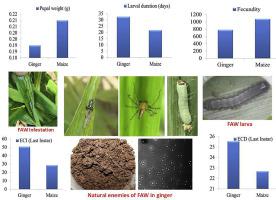当前位置:
X-MOL 学术
›
Crop Prot.
›
论文详情
Our official English website, www.x-mol.net, welcomes your
feedback! (Note: you will need to create a separate account there.)
Bioecological attributes and physiological indices of invasive fall armyworm, Spodoptera frugiperda (J. E. Smith) infesting ginger (Zingiber officinale Roscoe) plants in India
Crop Protection ( IF 2.5 ) Pub Date : 2020-11-01 , DOI: 10.1016/j.cropro.2020.105233 D.M. Firake , G.T. Behere
Crop Protection ( IF 2.5 ) Pub Date : 2020-11-01 , DOI: 10.1016/j.cropro.2020.105233 D.M. Firake , G.T. Behere

|
Abstract Invasive fall armyworm (FAW), Spodoptera frugiperda (J. E. Smith) (Lepidoptera: Noctuidae) of American origin, has recently arrived in Asian countries, found damaging maize and other host plants including ginger (Zingiber officinale Roscoe) in India and China. The ginger is an economically important spice and a medicinal cash crop of Asia. However, apart from just an occurrence, no other information is available hitherto on interaction of FAW and ginger plants. This is the first comprehensive report unfolding the FAW infestation to the ginger crop, including its bioecological and physiological aspects. FAW identity was confirmed at the molecular level by comparing the sequences of the CO I gene of mitochondrial DNA. FAW infestation was higher during mid-July (0.2 larvae/m2), when ginger plants were in rhizome initiation stage (critical stage of growth). Besides generalist predators, four natural enemies were found causing a total of 74.03% fortuitous biocontrol of FAW larvae. Biological attributes and nutritional indices of FAW were studied on ginger for 3 consecutive generations. The larval duration has significantly extended; however the body weight and lifetime fecundity were considerably reduced in ginger fed larvae than maize. The Consumption Index (CI), Relative Growth Rate (RGR) and Approximate Digestibility (AD) were significantly lower (Mann-Whitney U Test, P
更新日期:2020-11-01











































 京公网安备 11010802027423号
京公网安备 11010802027423号